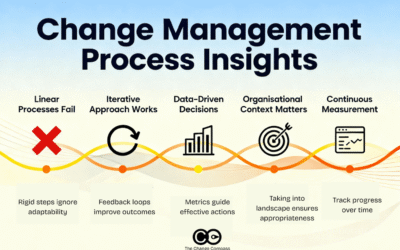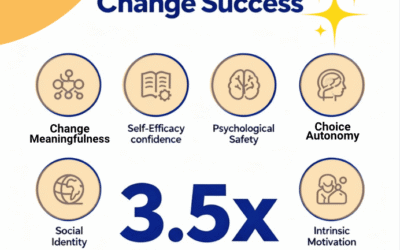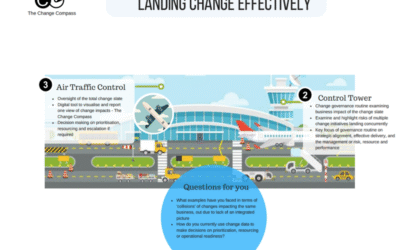The world is now watching and experiencing an emerging coronavirus pandemic. There is widespread anticipation and fear in many parts of the world, especially those with higher rates of infection. This poses an interesting scenario of testing the capability of organisations in managing change during coronavirus. And in fact …. the virus itself is a change that forces organisations to work and organise itself differently.
The change caused by coronavirus is vast. Travel bookings are cancelled and prohibited. Employees in highly infected areas are told to work from home. Expatriates are sent home and many face forced quarantine. In Australia, Australian evacuees from Wuhan in China (where the virus was first spread to humans) are placed in Christmas Island detention centres. In many parts of the world, cities have become ghost towns. Soccer stadiums lay empty. Some countries have even closed borders to countries infected with high rates of the virus. In Hong Kong office staff are working from home, along with their partners. And often within close proximity of where their children are playing, which can be challenging.
No doubt about it – the coronavirus is one of the tests of an organisation’s ability to undergo change. Some are more prepared than others.
So how does an organisation manage the changes inflicted by coronavirus?
Change leadership
Most companies follow the usual approaches of sending out notifications on company policies and any restrictions such as business travel and working from home policies. However, in this time of uncertainty leaders need to stand out and help navigate through the various changes caused by the virus.
This means communicating early and frequently about what is happening and relaying any useful information as needed such as travel and technology needs. Leaders need to gage any employee sentiments and concerns about what is happening around them. Promote discussions as needed to sense-check any employee concerns and offer support.
Effective change leaders also need to proactive interpret what the changes mean to the team and assess the various impacts of the change. Does it make sense for all team members to work from home? Are there any connectivity issues? Does the team have the skills to work virtually? How are the team’s deliverables going to be impacted by the virus in terms of potential increases or decreases in workload? What other teams might benefit from the support of the team in the current environment?
Rules of engagement
With any significant changes in ways of working and operating there needs to be clear rules of engagement set for employees.
For example:
- To support virtual working what are the ground rules if any in terms of responsiveness and virtual engagement? Does there need to be regular individual checking throughout the meeting to ensure everyone has a chance to speak?
- Are there meeting rules that are required to ensure the team remains cohesive and engaged? Does there need to be a separate minute taker, time keeper, etc.?
- Do individual expectations need to be reset within a changed workplace? How does everyone show their work output within a virtual environment? And what is the expectation on virtual collaboration?
- Are there rules of expectations for those who are sick or have a cold/flu in terms of not being in the workplace?
- How is performance evaluated within a virtual working situation?
Agile organisations can easily bend and flex according to changing industry pressures and customer requirements. If business volumes drop, what are the ways in which the organisation can scale down as needed to stay afloat? This is more than just about business continuity plans as it is about the flexibility of the operating model and ways of working to undergo rapid change.
Using virtual tools for collaboration
When the previous epidemic SARS hit back in 2003 working virtually was less prevalent. Now, equipped with a range of technological tools, organizations can easily make things work much more effectively in a virtual environment.
The trick is not to assume that one magical tool will meet all of your needs. Instead, use different tools for different purposes. Here are some digital tools that may help:
- Telecommunications: Google Hangout, Skype, Zoom
- Project tracking: Basecamp, Trello, Jira
- Online discussion boards: Microsoft Teams, Slack, Yammer
- Virtual collaboration: Draw.io, Google Docs
- Visual graphics: Canva
Working virtually can also mean that some of the body languages cannot be seen and therefore using visual aids is more critical in a virtual working environment more than in a face-to-face situation. Using visual aids helps to make communication even clearer and easier to follow for the audience.
Draw.io is worth mentioning as it is free and also super easy to use. There is a range of different templates that are ready to use. A team can use this to start brainstorming ideas, work through a logic tree, fill in a flow-chart, develop a project approach, define a timeline, etc.
Balancing planned initiatives
Most organisations are already balancing multiple changes at any given time prior to the arrival of coronavirus. What this means to most organisations is that the impact of coronavirus is one more change that piles on top of existing change initiatives.
Organisations need to carefully assess the planned set of changes and ascertain to what extent existing changes may need to be tweaked as a result of the virus. Do initiatives need to be delayed or paused? Or will the implementation approach need to be different as a result of the virtual nature of work for more targeted employees? Will communication mediums need to change as a result? What about learning mediums? What are the feasible learning platforms and how effective are these for targeted employees?
Data visualisation tools for change such as The Change Compass can provide a visual way of understanding the volume and pace of change across the organisation. In particular, assessing the collective impacts of events such as the virus on the employees given other planned changes. This, in turn, can help with business decision making regarding the roll -out of the various changes to maximise business readiness and adoption.





